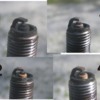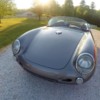Engine info first:
2276 Type I, 44 Webers 65 idle 150 mains 220 air F11 tube, 009 Distributer (clone?)w/compufire, NGK D7EA plugs, 40mm Intake 35.5mm exhaust valves, FK 8 cam
I reset floats at 10 and 25 and put in some fresh plugs set at .70mm. The original plugs were showing some richness. Idle screws were 1.25 out. Checked the timing, 28. I went out for a ride. It ran great. Minimal stumble in the transition zone 2500 rpm. Good power, I was having a blast. I turned around in a parking lot and when I went to give it some gas at about the 2500-3000 and up, it started stumbling and popping real bad. I was passing some **** box car, so I guess Karma caught up to me, and kicked me in the nuts. It did this the whole way home.
I did have some mild backfiring on deceleration during the fun part. I did notice that there is an exhaust leak where the J pipe joins the 2way before the muffler on cylinder 3.
The next day I rechecked the valves, cleaned all of the jets (idle, main, and air), shot some carb cleaner through the idle circuit, started and warmed it up and checked the balance. The carbs were balanced at idle, but as soon as I upped the rpms to about 2000, 3 and 4 weren't responding. 1 and 2 would be about 10 and 3 and 4 would be about 6 on my snail meter. I sprayed water on the exhaust near each cylinder, and the water sizzled equally on all of them. I checked the linkage rods during idle, and it was good. I disengaged one, and no change in idle. My linkage rods aren't exactly at the same angle. I need to work some more on this, but it was running good as it is. I went out for a test anyway, but the same thing happened.........
What to do now????? Recheck carb floats on the #3/4 carb, fuel filter at carb, join the Devil and get a Subie motor? The gas line connects to this carb first then it runs to the #1/2 carb.
It did backfire through the #3/4 carb once during a start while testing.
Depressed, Carlos





